Bally Brand
Bally Foundation Presents "Un Lac Inconnu", An Inaugural Exhibition
Luxferity, 13.04.2023
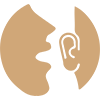

20 April – 24 September 2023
Bringing together more than twenty international artists, Un Lac inconnu proposes a poetic and philosophical walk between submerged and emerged landscapes, an attempt to give form to the water that slips through our fingers and yet traces a furrow. A proposal to connect with oneself and the world.
- Vito Acconci
Born in 1940 in New York (USA) – died on 27 April 2017 in New York
Bodies in the Park, 1985
Sculpture set, metal, wood, plastic and astroturf
MAMCO Collection, Geneva
Donation from the Centre d’art contemporain de Genève
A unique figure in contemporary art, the American artist of Italian origin Vito Acconci has long worked to break the boundaries between private and public, artistic creation and daily life, conceiving works on a human scale, often with a light touch of humour. After publishing a collection of poems, he turned to the visual arts with a work centered on the body, which took the form of provocative physical performances from very early on, making him known within the New York scene. From the 1980s onwards, after integrating videos and installations into his work, he was also interested in architecture, urban planning, and landscaping, conducting studies to create shared spaces for meetings, exchanges, debates, and games.
His unclassifiable practice constantly challenges the public, possibly the citizens: from the space of the page to the one of the city, he jostles, provokes, creates ambiguous universes, forcing questions and direct participation. ‘Bodies in the Park,’ a set of sculptures covered with artificial foliage, first evokes the topiary art characteristic of the French garden. However, rather than making country-style plant sculptures representing, for example, animals or trees, here the human silhouettes are cut like hedges in a garden. The ensemble proposes a rather radical vision of the idea of “becoming one” with one’s environment, eliminating the border between man and nature, between organic and mineral matter, between image and self-image. Man becomes his own support (chair and table), his own shelter (human arbor), nymph and bench: the body imposes its power, defining his only decoration. Thus, the public landscape, the furniture that can be shared in the gardens, is transformed into a private and intimate space, full of humor and yet inaccessible.

Vito Acconci, Bodies in the Park, 1985
Sculpture set, metal, wood, plastic and astroturf
Photo © Annik Wetter
Courtesy of MAMCO, Genève
- Wilfrid Almendra
Born in 1972 in Cholet (France), he lives and works in Marseille and Grenoble.
Le mouvement de la danseuse, 2022
Galva tube, steel, copper tubes, peacock feathers, cast aluminum,
paint, crust of rock 240 x 120 x 94 cm
Slug, 2022
Cast Alumium, lapis-lazuli painting, 2 x 12 x 2 cm
Slug I, 2022
Cast Bronze, 2 x 12 x 2 cm
Slug II, 2022
Cast Bronze, 2 x 12 x 2 cm
Slug III, 2022
Cast Bronze, 2 x 12 x 2 cm
Courtesy of the artist & galerie Ceysson & Bénétière, Paris
Coming from a family of Portuguese immigrant workers, sometimes himself an artist-farmer cultivating vineyards and fruit trees, Wilfrid Almendra is inspired by the motifs of the history of art and architecture as well as his past and daily life. His sculptures and installations are often made with poor or industrial materials, recovered, exchanged, recycled, then transcended by technical experiments and poetic inventions, where the beauty of the landscape paradoxically refers to the working-class environment. The artist thus deploys a kind of wastelands conceived as open works, leaving place for projection and interpretation. In his work, Le mouvement de la danseuse, gravel replaces fresh grass or fine sand and peacock feathers extend steel rods planted on the barren landscape. This strangely harmonious landscape, at the edge of the mineral, animal and industrial worlds, creates a balance between the precious deployment of the peacock and the poverty of the other materials. The bird turned flower, enthroned on this rocky field, dancing according to the winds, gives the whole piece a spiritual aura. These association games also carry a powerful narrative potential: which world do these ruins come from? What landscape to reinvent? In a permanent movement of (re)construction, starting from the very product of demolition, Wilfrid Almendra also rethinks our systems of economic and social relations, and the indelible traces left by man in nature, both symptoms and symbols.

Wilfrid Almendra, Le mouvement de la danseuse, 2022
Galva tube, steel, copper tubes, peacock feathers, cast aluminum, paint, crust of rock 240 x 120 x 94 cm
Photo © Aurélien Mole
Courtesy of the artist & galerie Ceysson & Bénétière, Paris
- Caroline Bachmann
Born in 1963 in Lausanne (Switzerland), she lives and works in Geneva (Switzerland)
Grand nuage jaune et gris, 2023
Oil on canvas, 80 x 80 x 2.20 cm – Kunsthaus Zurich Collection
Grands nuages oranges reflet, 2022
Oil on canvas, 80 x 80 x 2.20 cm
Rayon nuage gris, 2023
Oil on canvas, 80 x 80 x 2.20 cm
Courtesy of the artist & galerie Gregor Staiger, Zurich
From her window, often in times when the light is less determined and more changeable at sunrise or sunset, Caroline Bachmann observes the Lake Geneva. Her sketchbooks are filled with drawings more than with notes: she records the minute variations in her environment and what it causes in her, paying attention to the time that goes by. Her work is meticulous. It translates lines and colors, lists winds and temperatures, transcribes light, the shape of clouds, water textures, and effects of reflections. She draws diagrams and symbolic formulas worthy of a semiotic essay or a mathematics notebook. The variations are incessant so that the same window also offers infinite possibilities. Caroline Bachmann develops new techniques with ease, playing with layers and transparency, aiming to transcribe almost invisible mutations. For the artist, it is a case of questioning the forms of repetition and series, of bringing the vision back to its conceptual expression, an allegory of a mental landscape where the apparent symbolism refers to a form of spirituality.
From recurring elements—water and sky, sun, moon and clouds—the artist paints several canvases at the same time, both connected and different, offering a panel of emotions, sensations related to the atmosphere, poetry, to that interiority that its exteriors reveal. If symbolism seems to dominate the paintings at first glance, Caroline Bachmann’s research is much more personal and intimate: the rhythm of her lines and the utilization of the colors create a synthetic effect of veduta. These views have a frame, painted on canvas, sometimes barely visible, others very present, tirelessly changing shape and color, a kind of porthole that, instead of enclosing, opens a window to the soul.

Caroline Bachmann, Double arc-en-ciel flottant, 2021
Oil on canvas 40 x 30 x 1,5 cm
Photo © Gregor Staiger
Courtesy the artist & Galerie Gregor Staiger, Zurich
- Oliver Beer
Born in 1985 in Kent (England), he lives and works between London and Paris
Resonance Painting (Lakeside 1), 2023
Resonance Painting (Lakeside 2), 2023
Pigment on canvas, 2 x 3 m
site-specific production
Courtesy of the artist
From the beginning, Oliver Beer has been working with sound as a “raw plastic material” and has been interested in the relationship between sound and space, especially through voice and architecture, seeing a possible instrument in any space. His study of the resonance frequency produced by different environments has given rise to series of projects such as the ‘Resonance Projects’, vocal performances using the natural harmonics of buildings and which he has been deploying repeatedly since 2007, or the ‘Resonance Paintings’, pieces that translate musical harmonies into visual language and are another example of these experiments. For these paintings, a speaker is placed below the canvas in order to make it vibrate. The sound waves then disperse dry powder pigments previously placed on them. These are then fixed by the artist in a single movement, characteristic of a specific note so that each canvas is different from the previous one, depending on the sounds chosen. Oliver Beer thus builds a vocabulary of abstract forms that gives substance to sound and develops a unique method of painting, where sound becomes the paintbrush. As he says, “people don’t realize that music has a physical form: If you could see music vibrating in the air around us, you would see beautiful threedimensional geometries.” The other constant of the ‘Resonance Paintings’ is their blue color, given by cobalt oxide, inspired by a blue and white vase that the artist found in his grandmother’s house and whose history he traced, through trade and colonial routes, the Portuguese, Dutch, and British empires, Japan, Korea, China and Iran where it was created. Within the exhibition Un Lac Inconnu, these latest ‘Resonance Paintings’ were made according to sounds recorded at several times in Lake Lugano with submerged microphones, in order to “visualize”, one could say, the underwater landscape facing us at Villa Heleneum, mysterious and full of life.
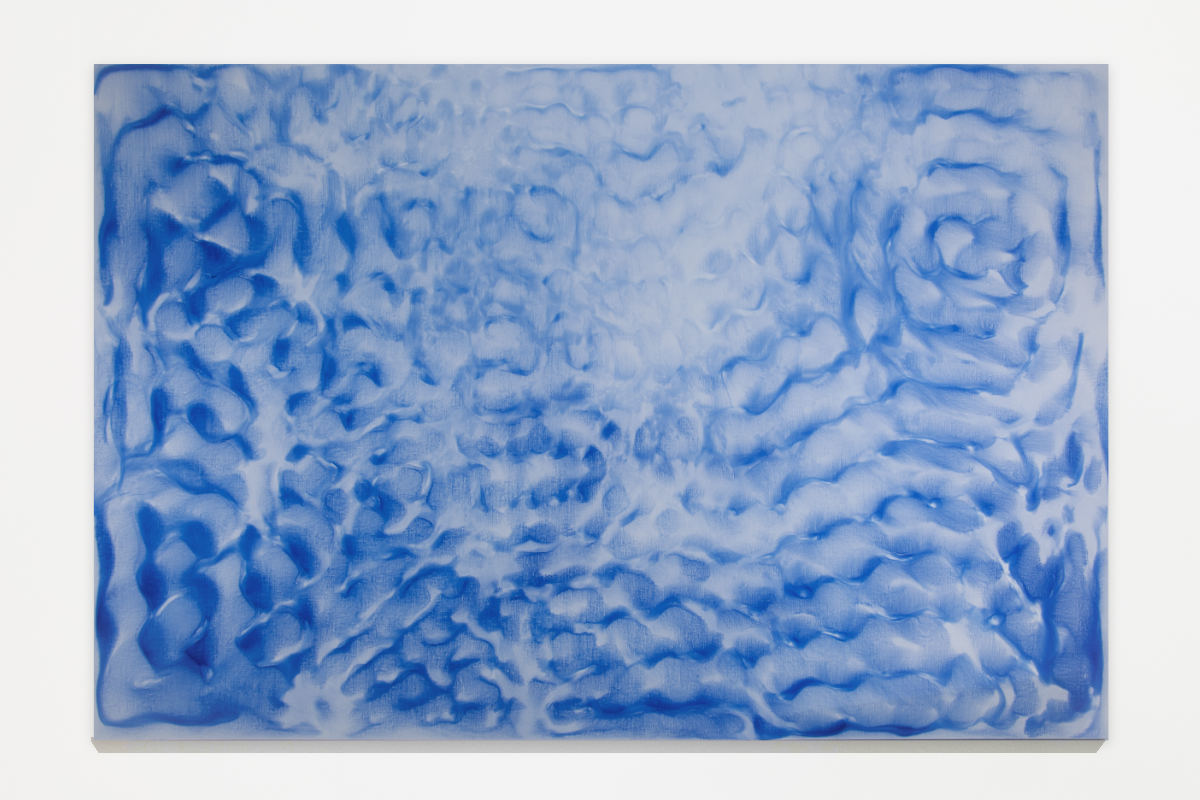
Oliver Beer, Resonance Painting (Lakeside 1), 2023
Pigment on canvas 200 x 300 cm
Courtesy of the artist
- Mathias Bensimon
Born in 1996 in Paris (France), he lives and works in Paris
Le lac intérieur, 2023
Fresco with potassium silicate, mineral pigments
site-specific production
“It is by the water that I best understood that reverie is a universe in emanation, a fragrant breath that comes out of things through a dreamer.”
Water and Dreams, Gaston Bachelard, 1942.
Mathias Bensimon’s work, a fresco that unfolds outside the Villa Heleneum, was born out of a contemplative relationship between the artist and the lake. Even before starting his painting, the artist focuses on a precise study of light and takes the time to experience the sensations that the landscape gives him. “The illusion of an endless whole, of a wave without horizon and shore,” Monet said of the Nympheas on display at the Musée de l’Orangerie in Paris. It is this feeling of infinity that Mathias Bensimon seems to be looking for, drawing a wave that echoes into the belly of Villa Heleneum. He chooses a portion of the lake and enlarges it, as if to probe both the surface and the depth. But his confrontation with the lake does not give rise to a figurative painting. If the young French artist does a whole lot of work on the light on the surface of the water that reveals the different shades of blue and transcribes the changing side of the matter, he also creates a sensitive space, like our bodies. This whole fresco informs the idea of penetrating the landscape and letting it penetrate us. The possibility of creating a cave, a passage to the interior of the villa, or a small chapel to be submerged from the inside/outside, by this rare possibility to face the painting that represents the real. A place where we suddenly find ourselves caught in the specularity between the lake as it is and the lake as we feel it. Between a landscape that can be seen—and it is true that light, clouds, and mist play an essential role in the perception of the painting—and a landscape that preexists in us. This installation opens the exhibition outside the Villa and solicits a memory whose levels have been sedimented like geological layers, seeking the genius loci of the site, revealing the very essence of the tenderness between the house and its lake.
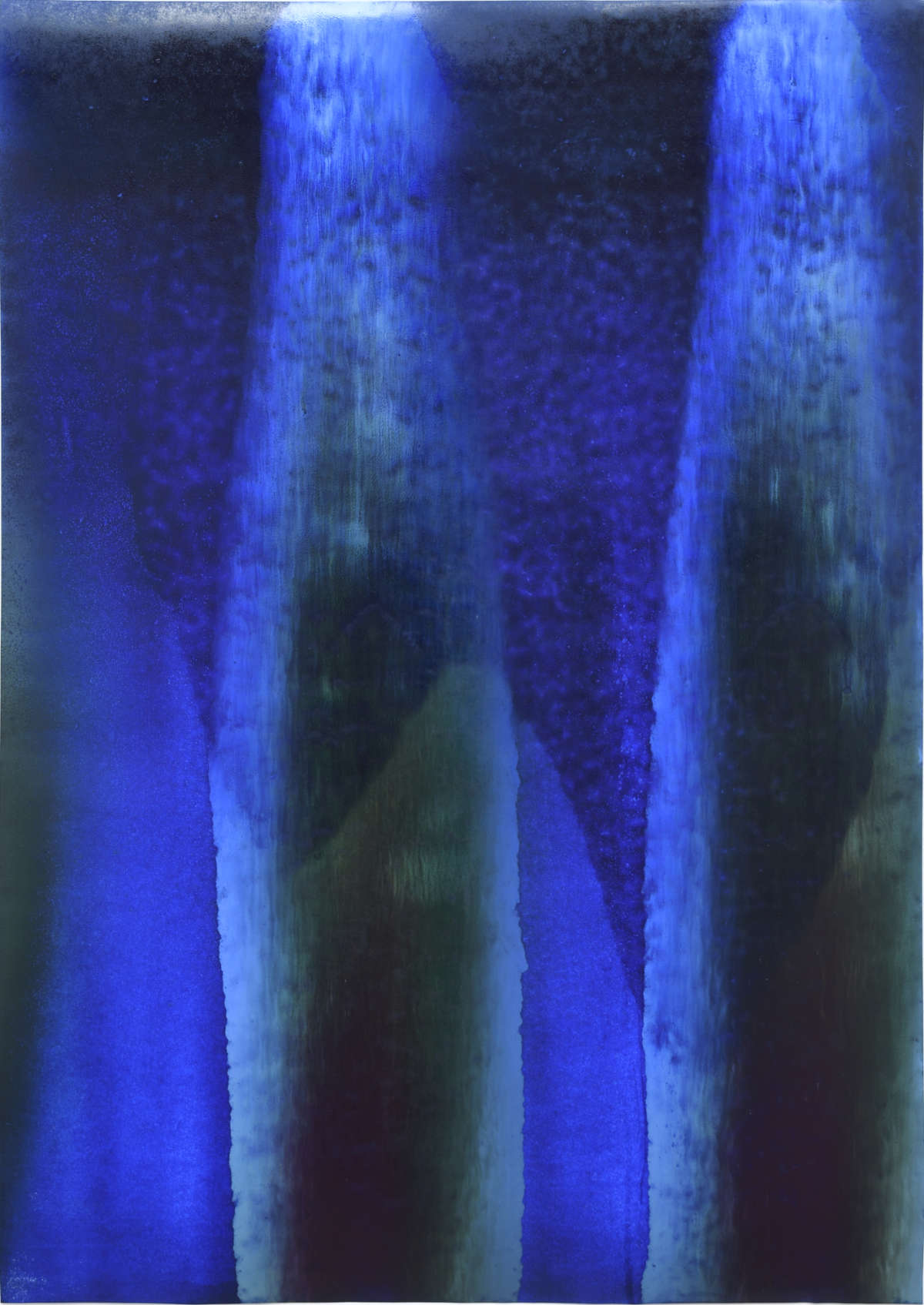
Mathias Bensimon, Valse bleue des flots, 2021-22
Oil on paper 100 x 70 cm
Courtesy of the artist
- Angela Bulloch
Born in 1966 in Rainy River (Canada), she lives and works in Berlin (Germany)
Unseen (Daylight), 1990
Lamp (white plastic sphere), daylight bulb, electric cable, switch, metal plate, ⌀ 30cm
MAMCO Collection, Geneva.
« Autour de Gilles Dusein », with support from the artist, Serge Aboukrat, Christian Bernard and Caroline Bourgeois
Angela Bulloch is interested in the semantics of space, whether real or digital, terrestrial or interstellar, drawing landscapes on the edge of aesthetic and mathematical territories. Her multimedia works, based on precise rules and formulas, decipher and expose the complexity of the control structures that govern the places she moves into. The British conceptual artist takes a critical look at our irrepressible need to subject reality to different forms of regulation and to organize our lives and relationships according to norms and systems. Through immersive and contemplative experiences, she studies how our interactions with objects structure and motivate our movement in space. Often abstract, her art appeals to the viewer’s imagination, allowing many possible interpretations. With its minimalist surroundings, which can almost be confused with a design piece, the work ‘Unseen (Daylight)’ illuminates the room and hypnotizes visitors. Faced with this simple round geometric shape, the relationship with the landscape may seem more abstract, but this unknown star invites a meditation on the beauty and complexity of the world, and a reflection on the relationship between technology and nature. Full moon or polar star illuminating a path in the dark night, its presence guides thoughts and brings out many questions: can a white plastic sphere reproduce effects similar to those provided by nature? Can a so-called daylight bulb simulate sunlight? Can it, like fascinating sunrises or sunsets, comfort hearts and minds? With a simple gesture, Angela Bulloch changes the atmosphere of the room, introduces the exterior to the interior, and questions the perception of time and space. The work is thus established as an exploration of light as a sensory, quasi-therapeutic experience.
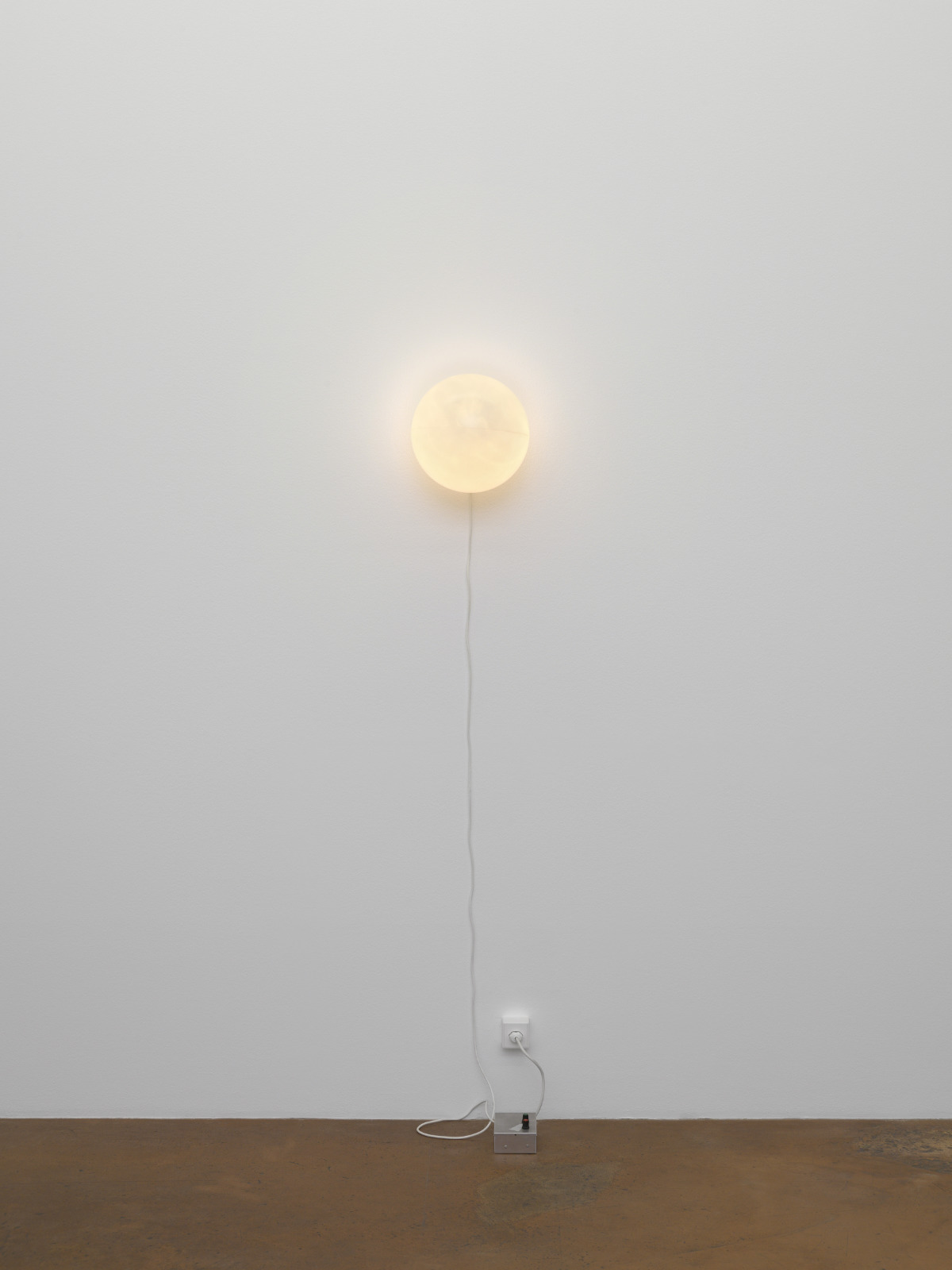
Angela Bulloch, Unseen (Daylight), 1990
Lamp (white plastic sphere), daylight bulb, electric cable, switch, metal plate, ⌀ 30 cm
Photo © Annik Wetter
Courtesy of MAMCO, Genève
- Ligia Dias
Born in La Chaux-de-Fonds (Switzerland), she lives and works in Geneva
ANTONI, 2021
Polyester, jewelry and discarded objects, everyday found objects, light devices, silver paint, gold leaf, silk, cork, crystal, glass, 275x250x150cm
Courtesy of the artist & Frac Normandie
Ligia Dias is an artist who works in the fields of art, design, and fashion, combining craft techniques and industrial elements, to create jewelry, sculptures, or “objects with poetic reaction.” The work ANTONI is inspired by the Spanish architect Antoni Gaudí who, at the beginning of the 20th century, created models from ropes suspended from the ceiling, to which he added weights, working with gravity to develop the arched and curved catenary shapes that he is known for. Ligia Dias revisits these impressive prototypes and adapts them to her practice. The sand weights of Gaudí give way to a variety of everyday or elegant objects: Champagne stoppers rub shoulders with beer capsules, crystal chandelier pendants flirt with souvenir key rings, metal elements evoking the world of precious stones mingle with scrap metal. Caught in their gigantic net, one would think they were taken from the nearby lake, traces and memories of a submerged life. Present and suspended, both playful and seductive, these pearls and trinkets could be waste or votive offerings. These objects that we carry, live with, offer, and forget, diverted from their original context and deprived of their primary function, take on a completely different value—no longer practical, but narrative. Can we read a universal constellation or traces of a personal archaeology in this sky of memories? The whole, highlighted and seen from below, transforms the trawl into a dreamlike, off-scale chandelier, below which a collective memory seems to be sheltering, both domestic and magical.

Ligia Dias, ANTONI, 2021
Polyester, jewelry and discarded objects, everyday found objects, light devices, silver paint, gold leaf, silk, cork, crystal, glass
275 x 250 x 150cm
Photo © Annik-Wetter
Courtesy of the artist & Frac Normandie
- Adélaïde Feriot
Born in 1985 in Libourne (France), she lives and works in Paris
Rayon vert, 2021
Cast aluminum and lead, polyester, 5 sculptures, 175 x 35 cm
Courtesy of the artist
A rare and fleeting optical phenomenon, the green ray appears at sunset: before it disappears behind the sea horizon, the star gives off a fine green light for a few fractions of a second. In response to and mirroring this natural magic that catches your breath and gaze, Adélaïde Feriot associates this phenomenon with a form of meditative contemplation. In her work, a set of five sculptures, made of lead and aluminum, appear strangely floating and at the same time anchored in the ground. The illusion of levitation is created thanks to the bundles of tinted tissues evoking a fountain of tears gushing from silvery faces with closed eyes.
Disturbing and poetic, these suspended faces are waiting for bodies coming to inhabit them, forming a chorus of voices with mythological accents. The work is a living painting and a Greek choir: imageflesh with body-statues that grab a moment and stretch it in the memory. Echoing his first inspiration, this elusive green ray, the duration of the composition is modeled on the time it takes sunlight to reach the earth. In a way, even in their physical absence, bodies continue to inhabit space, as if the works had been charged with their energy through singing. Here the artist creates a perfect balance between landscape and body, natural and baroque, movement and immobility. We understand that Adélaïde Feriot’s research focuses on how we perceive images and time as living and plastic material. Rayon vert (Green rays) is thus part of a larger body of works honoring horizons, seasons, stars, and winds, recomposing natural phenomena and evanescent landscapes within a three-dimensional space.

Adélaïde Feriot, Rayon vert, (détail), 2021
Cast aluminum and lead, polyester
Photo © Gerald Petit
Courtesy of the artist
- Karim Forlin
Born in 1977 in Locarno (Switzerland), he lives and works in Geneva
Bisogna trovare un altro paesaggio, 2023
Wood, metal, and acrylic paint
Site-specific production
Courtesy of the artist
Karim Forlin, an artist originally from Ticino, creates a new production from the gardens of Villa Heleneum and their stories. As a keen observer of the territory, he first deciphers the multitude of signs that he detects on the spot. His practice consists of exploring in particular the different meanings that simple figures can suggest, the narratives they evoke, the systems they establish, the benchmarks and the limits they create. He is thus interested in the symbols that populate our world or rather in the way in which language and colors inhabit and order the landscape, studying the representations of cadastral markings such as the signage of cities, or these signs that are sometimes found in the forest to indicate a path or tell the history of trees. The clues he finds in the surroundings of the villa lead him into a labyrinth of assumptions and constructions, establishing a dialogue with the space. Stones make the shape of a sun on the ground. In response to this orb and its rays (which suggest the ramifications of past paths), Karim Forlin builds an octagonal shape made from assembled benches. Each bench is marked with a letter from the old Lugano alphabet* and the whole piece makes up the word “apertura” (opening). The seat thus delimits an interior/ exterior space of thoughts and actions, an agora and an arena, inviting solitary contemplation as much as collective debate, ritual as much as performance, tributes, and links between the Villa and other circles of energy and culture, from Eranos to Monte Verità. The color here, pink, is also sign and signal. A few steps away, at the top of a staircase that no longer leads anywhere, is a blue which catches the eye. The artist restores depth to a door that time has made invisible. The brilliant ultramarine lacquer then reflects daylight and creates a bridge between the azure of the sky and the lake, a vanishing point or an exit to another landscape, shaped by man.
* Lepontic, a continental Celtic language spoken by the Lepontii in a region of about 100 kilometers around Lugano, in the lake region between northern Italy and southern Switzerland, from the 7th to the 2nd centuries BC.
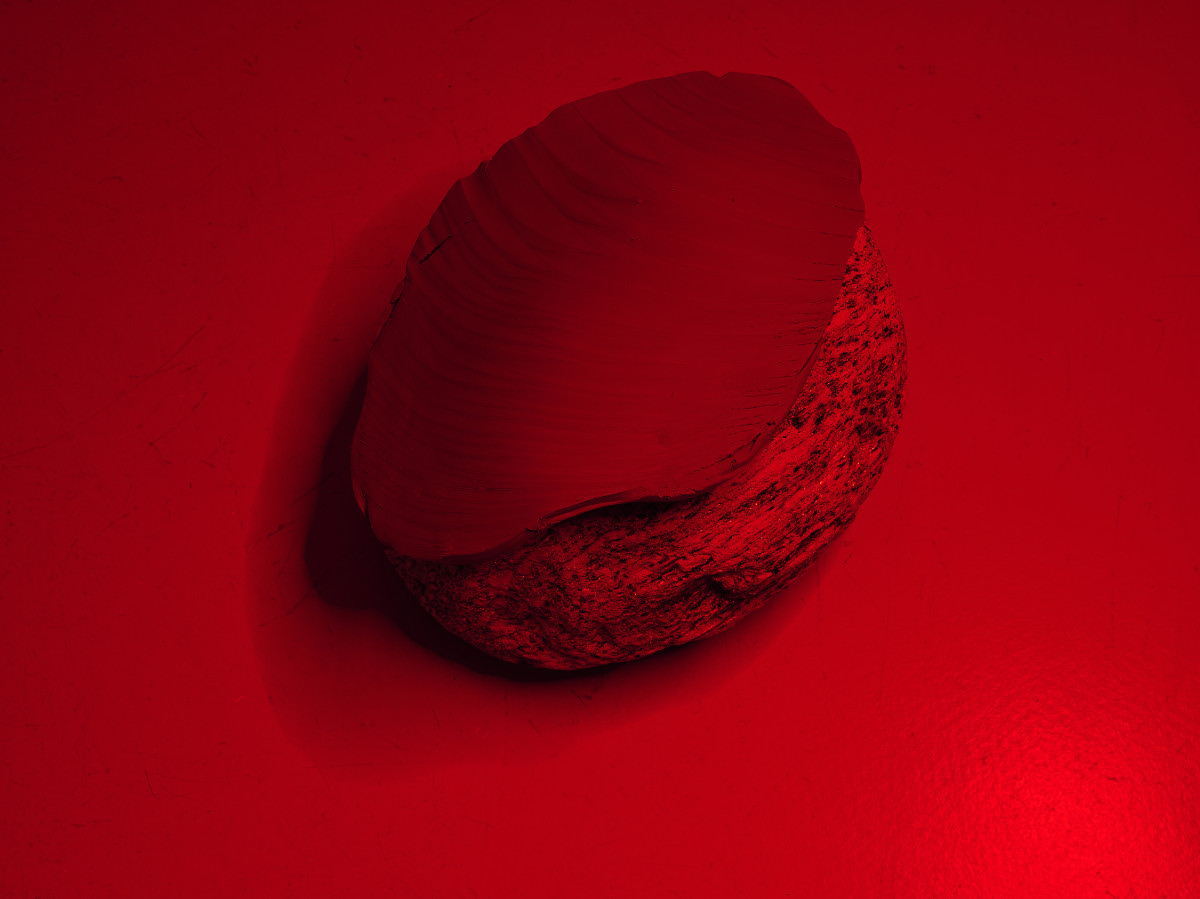
Karim Forlin, Pietra sangue (d’après Fabio Pusterla), 2022
neon and stones covered with dried clay, variable dimensions
Photo © Nicolas Delaroche
Courtesy of the artist
- Tania Gheerbrant
Born in 1990 in Paris (France), she lives and works in Paris
Twin in the clouds and other stories, 2023
Wood, fabrics, dyes, glass lenses, chrome metal, screens, three video channels, 12 min.
Site-specific production
Courtesy of the artist
Tania Gheerbrant presents the first part of a new multimedia project revisiting our ways of seeing, hearing, and perceiving the world. With ‘Twin in the Clouds and Other Stories’, the artist begins an in-depth research through the ages around a psychic phenomenon known as “hallucinatory”: hearing voices. If in the past these manifestations could be considered prophetic revelations, divine signs, or magic, they are today mainly the subject of medical and psychiatric studies. Far from this diagnostic approach or a quest for a scientific response, Tania Gheerbrant essentially approaches this phenomenon from an artistic and metaphorical point of view and ascertains it as a rich expression of meaning emanating from a powerful subconscious.
To better immerse visitors in this universe, the artist creates a contemplative installation facing the landscape referring to both the boudoir and the psychoanalytic couch: sitting on this double bench implies agreeing to immerse oneself in the troubled waters of an unknown lake blurring the boundaries between documentary and fiction, the real and the imaginary. Three video lenses are inserted in the seat like portholes to inner lives. This parade of stories, images and sounds is inspired by the testimonies of people who hear voices, like the story of Jaj who, in addition to recounting his experience in a recorded interview, performs a rewriting of the song ‘Les Dingues et les Paumés’ over a clarinet tune played by Constantin Jopeck in the film. The montage also introduces the story of Aimée F., played by Jany Lauga, who talks about her conversations with birds. The whole piece is intertwined organically with landscape views created by the artist in Lugano, weaving a strong poetic link between nature and psyche, water and madness. And it is in this game of echoes that questions arise or doubts emerge redefining our understanding of what is called “mental health”. Through these flows of thoughts and voices, the artist invites an intimate reflection on how we comprehend reality, physically and emotionally. Finally, in each of these lenses, a bit of the unconscious landscapes of the visitors is reflected.
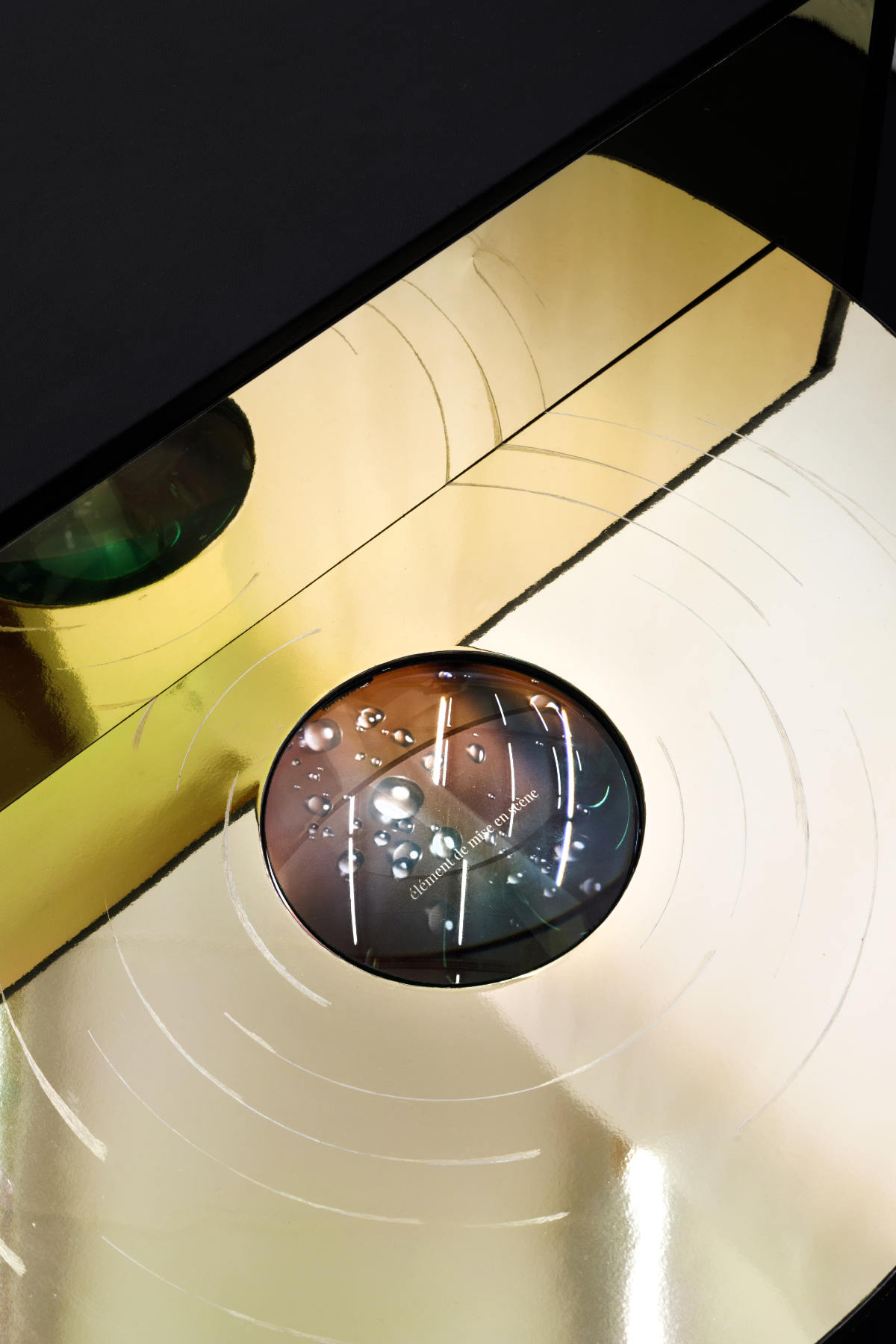
Tania Gheerbrant, It’s raining today (détail), 2021
wood, skai, gold aluminium, glass lens, tablet, colour video 3 min (loop)
Photo © Salim Santa Lucia
Courtesy of the artist
- Petrit Halilaj & Álvaro Urbano
Born in 1986 in Kosterrc - Skenderaj (Kosovo), Petrit Halilaj lives and works between Milan and Berlin
Born in 1983 in Madrid (Spain), Álvaro Urbano lives and works between Milan and Berlin
27th of March 2012 (Forsythias), 2020
Stainless steel, canvas, acrylic paint, wire, 2.7 x 1.5 m
Courtesy of the artists & galerie Mennour, Paris
Petrit Halilaj and Álvaro Urbano’s forsythia flowers settle inside the exhibition space like climbing plants. Heralding spring with their golden yellow color, they are often seen as symbols of splendor and abundance. They draw a new Garden of Eden, both an area of intimacy and a seed dissemination center, irrigating all the rooms of the villa. The outdoor gardens symbolically penetrate the place to form a monumental ensemble whose imposing appearance cannot however mask the personal history that gave rise to them. A nest designed as a shelter for Petrit Halilaj and his partner Álvaro Urbano. A flower to share and spread this love. A work like a poetic and political manifesto.
Romantic celebration and act of freedom, this proposal also creates a porous space in the exhibition that transfigures the external panorama into an introspective landscape and invites you on a walk that is both confidential and universal. In the shade of the flower sculptures, visitors are encouraged to connect to the natural world as well as to their own emotions. Petrit Halilaj and Álvaro Urbano have independent practices, but since 2014 they occasionally combine their research. Their joint work aims to break the binary separations between animal and non-animal or between natural and built environments in a playful and lyrical way. The couple creates time-spaces, architect of an immersive theater where residents and visitors become actors and co-authors of a common history. In these places, the hope of changing reality through a detour through fiction reigns. Their approach thus suggests the concept of heterotopia developed by Michel Foucault to describe existing utopias, such as gardens: “the garden is a carpet where the whole world comes to accomplish its symbolic perfection, […] it is the smallest parcel of the world and then it is the whole world.”
* These words were spoken by Michel Foucault during his conference on March 14, 1967, presented at the “Cercle d’études architecturales” in Paris
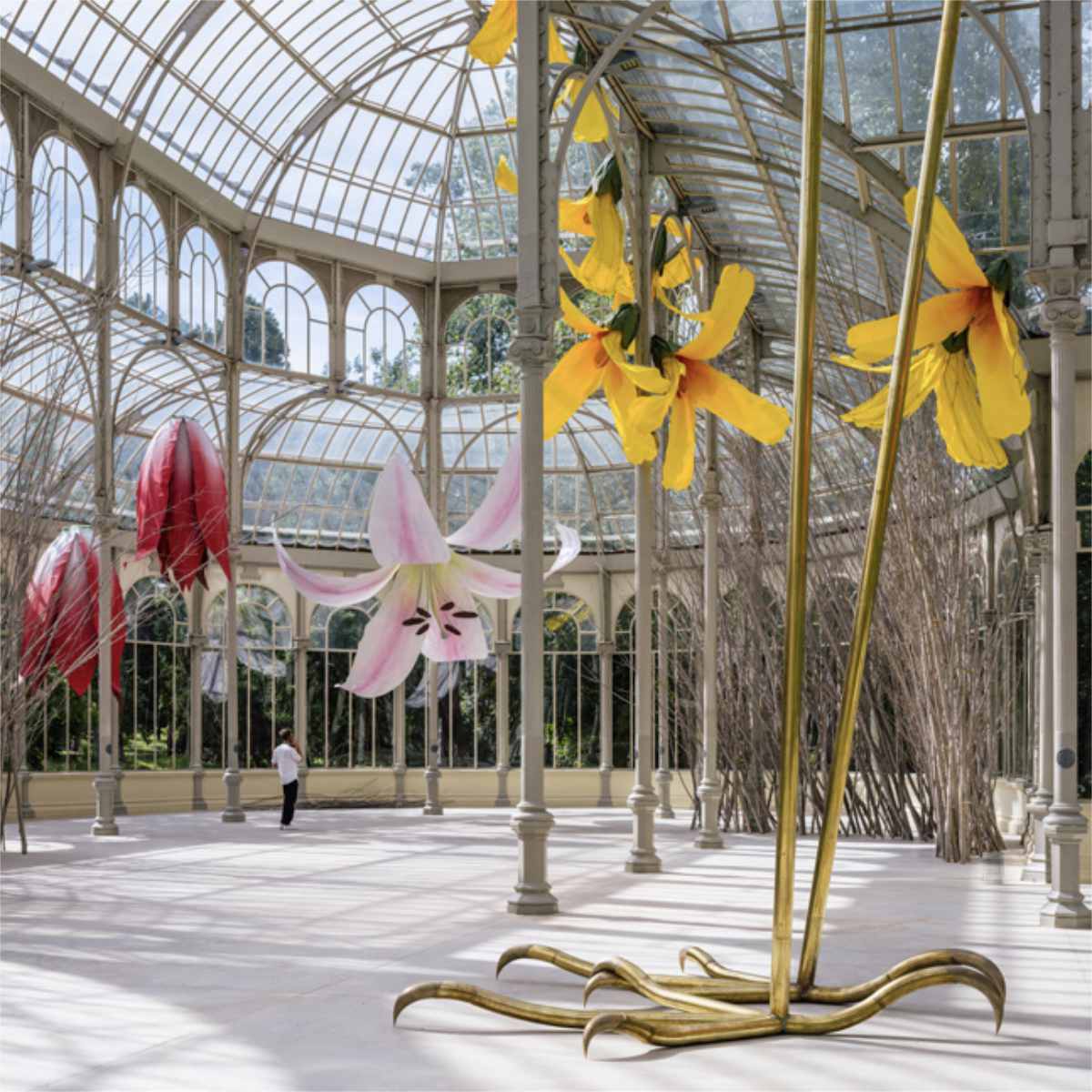
Petrit Halilaj avec Álvaro Urbano, exhibition view
« To a raven and hurricanes that from unknown places bring back smells of humans in love. », Museo Reina Sofía – Palacio de Cristal, Madrid, 2020-2021
Photo © Imagen Subliminal.
Courtesy of the artists & Mennour, Paris; ChertLüdde, Berlin
- Yannick Haenel
Born in 1967 in Rennes (France), he lives and works in Paris
Lac, 2023
Site-specific production
Courtesy of the artist
In the intimacy of Villa Heleneum, even within the folds of its history, lies a text written by Yannick Haenel on the occasion of the exhibition. The author has already worked around mythological stories related to the lake, with his short film ‘La Reine de Némi’ in 2017. The love story between Diane and Actaeon was performed again with the possibility of Actaeon surviving his encounter with the naked goddess. If, in the legend, it is a stealthy look at the deified female body that makes love impossible, in this latest story, Lac, the author dissolves the membrane between the Villa and the water, the body and its skin, and responds in a way to the Proustian definition of the subconscious. This unknown lake is that of the night that inhabits and envelops the depths of our dreams, the fire of our passions, the naked sleep between the sheets.
Writer Yannick Haenel has published novels and essays on art, including: ‘Le Trésorierpayeur’ (Gallimard, 2022), ‘Déchaîner la Peinture, Adrian Ghenie’ (Actes Sud, 2020), ‘La Solitude Caravage’ (Fayard, 2019), ‘Tiens Ferme ta Couronne’ (Gallimard, 2017, Prix Médicis) or ‘Jan Karski’ (Gallimard, 2009, Prix Interallié). Former resident of the Villa Medici in Rome, he is a columnist for Charlie Hebdo and an associate artist at the National Theatre of Brittany in Rennes.
Extract from Lac:
“Le soir, enfin, on glisse dans un lac. Les pensées s’ouvrent comme des fleurs en papier ; et voici que dans l’eau mon corps s’effiloche comme une algue. En m’effaçant, je deviens ce lac. Ce cratère où la nuit m’accueille était d’abord un volcan : je le sais car vivre, c’est être ardent. C’est moi qui chaque jour, avec mon feu, creuse ce trou. S’il se remplit, c’est à l’instant du soir où j’y tombe. Le lac n’existe que lorsque je perds conscience... ”
- Rebecca Horn
Born in 1944 in Michelstadt (Germany), she lives and works in Germany
Belle du vent, 2003
Volcanic stone, rock crystal, engine, pedestal, 43 x 27 x 16 cm
Giancarlo and Danna Olgiati Collection, Lugano
Internationally renowned German artist, Rebecca Horn is known for her performances exploring the human body and its physical limitations, possible extensions, protection, and sublimation, as well as her approach to restrictive social codes and standard behavior. In addition to a large body of performative works and videos, she is also known for her kinetic sculptures, animated objects participating in a poetic process of reconditioning the body, even altering and transforming it. Often, the component elements of her art can serve as mechanical substitutes for the body, suggesting ambitions worthy of automaton. ‘Belle du vent’ is one of these objects: a volcanic stone moves, using an engine, in front of visitors. Sawn in two, it opens and lets us discover a crystal at its heart, the word “heart” here probably being the key word. Translucent quartz, a precious stone with a fragile look, used since antiquity for its healing properties, protected, imprisoned, then released by a volcanic rock, petrified lava, a cover that reveals or hides this vulnerable intimacy. It is with this translation, this projection outside oneself, that the bodies of her first performances are replaced, piece by piece, by mechanical objects, with a strong allegorical dimension, a barely veiled eroticism and an animistic sensibility. A work that is always alive and expresses the potential of movement, its energy, its rhythm, the rituals and the metamorphoses of the body. Like a small theater of what pulsates in each of us.
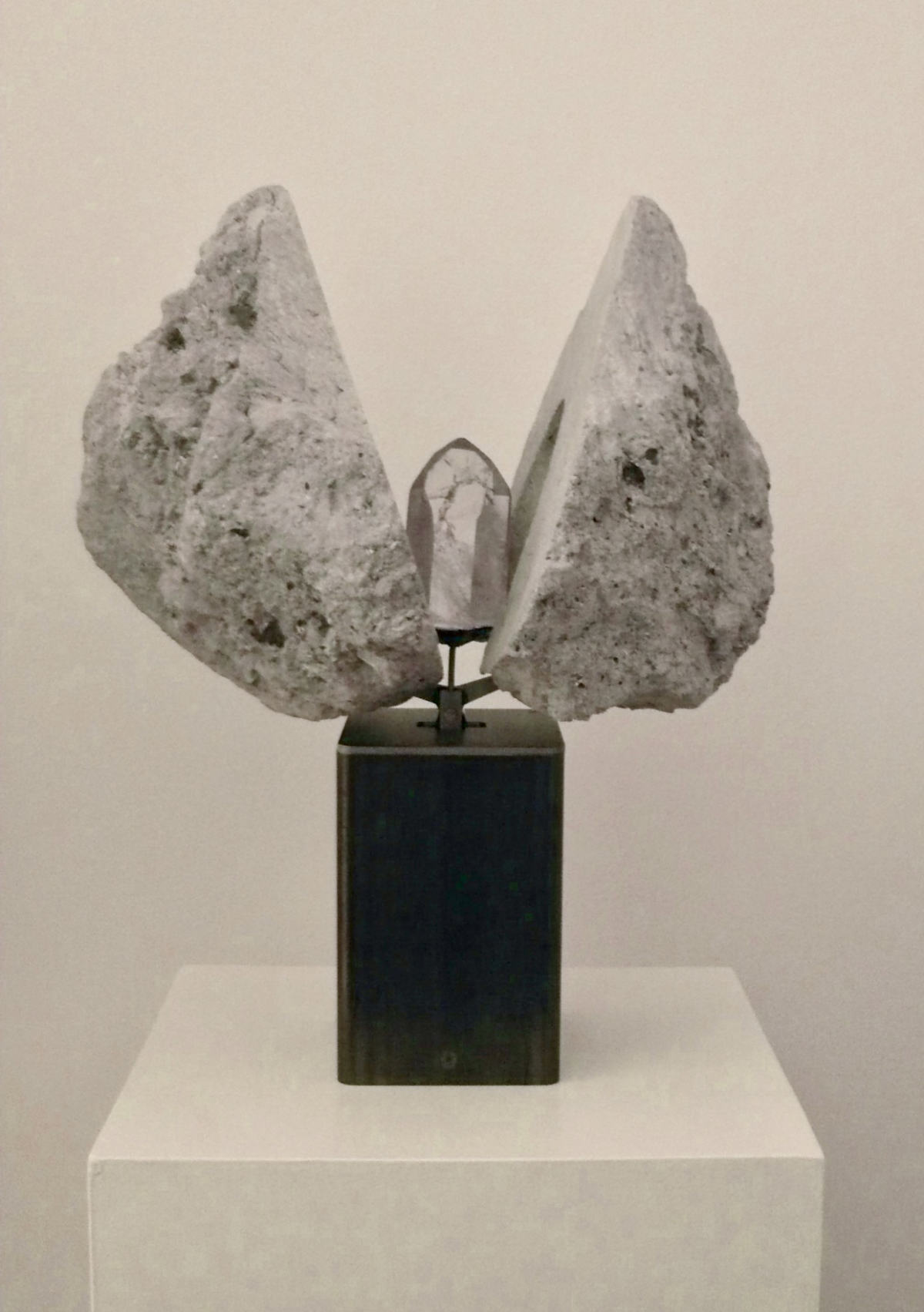
Rebecca Horn, Belle du vent, 2003
Volcanic stone, rock crystal, engine, pedestal, 43 x 27 x 16 cm
Photo © Agostino Osio
Courtesy Giancarlo et Danna Olgiati Collection, Lugano
- Paul Maheke
Born in 1985 in Brive-la-Gaillarde (France), he lives and works in Montpellier
Feeling the Tides Within the Fluids of My Body, 2019
Digitally printed text on curtains
3 curtains 135 x 370 cm, 4 panels: 135 x 400 cm
Courtesy of the artist & galerie Sultana, Paris
“When I am by the sea, the expanse of water envelops me with unchanging peace and excitement, as if I had found a precious stone in the earth, the feeling of touching something that is essentially me in a place where my past and my future intersect in the present. The present, this line of voltage, connection and performance, this intense moment of noise. But only the earth and sky are eternal, and the ocean unites them. I hear the song of the waters, I feel the tides in the fluids of my body, I hear the sea echoing my mother’s voice of survival.”
Audre Lorde, A Burst of Light: Living with Cancer (1986)
Based on decolonial thinking, Paul Maheke’s practice focuses on examining the power structures governing a certain Western reading of the world. To better defuse these oppressive systems, the artist honors the invisible forces (whether physical, political, or mystical), guiding and sculpting our experiences and identities. Through these processes, Paul Maheke initiates a rethinking of individual and collective imagination and memory, participating in a movement to rewrite the history of representations of the body and black and queer cultures. According to the artist, this rewriting requires a reinvention of language, which is itself a coercive framework, and this is certainly why his work often invokes the words of poets and other wordsmiths. ‘With Feeling the Tides Within the Fluids of My Body’, he refers to Audre Lorde, quoting a newspaper entry from the 20th of February 1986, when the activist author, fighting against cancer, went to the seaside. In this text, she describes her environment as inseparable from her body. This alliance seems to give her more strength to face the violence of the world and allows her to see hope of a cure on the horizon. Printed on translucent curtains in brown and black tones, inspired by the colors of photos taken underwater in a river linked to the artist‘s childhood, the text becomes an image and draws a semantic landscape. If the curtain is often considered a means of hiding, of separating, it is rather, in the work of Paul Maheke, a bridge between interior and exterior. The work gives a view of the subconscious without cutting us off from the external landscape and its light materials move, according to the wandering of the visitors. Fluid and porous bodies, they make it possible to bring together thoughts, words, bodies, and worlds, and make them coexist. They also delimit a space of thought that is both poetic and committed. Under the guise of a domestic object, the politics of the intimate reveal themselves. Curtains protect at the same time as they expose and thus become a symbol of resilience strategies, a form of resistance embracing vulnerability.

Paul Maheke, Feeling the Tides Within the Fluids of My Body, 2019
Digitally printed text on curtains
3 curtains 135 x 370 cm, 4 panels: 135 x 400 cm
Courtesy of the artist & Galerie Sultana, Paris
- Hélène Muheim
Born in 1964 in Annecy (France), she lives and works in Montreuil
Horizon - Rémanence 11, 2022
Eyeshadows, ink, and graphite powder on paper, 70 x 200 cm
Shivered spinal#2, 2021
Eyeshadows, ink, and graphite powder on paper, 70 x 200 cm
Enduring Memory, 2018
Eyeshadows, ink, and graphite powder on paper, 70 x 200 cm
Courtesy of the artist & galerie Valerie Delaunay, Paris
Hélène Muheim proposes new representations and perceptions of the landscape, made with powders as evanescent as her drawings are mysterious. Moreover, her works can be apprehended in different ways according to the distance at which one stands to observe them, the light that touches them, or the direction from which one looks at them. Peaceful clouds and voluptuous valleys at a distance, they are transformed closely into myriads of details. The artist plays with scales, manipulating the excessively large and the infinitely small at the same time, as if to better create a form of ambiguity between the representation of the landscape and its ephemeral dimension, a crack in the blank page, a portal to the imaginary. Her fantastic ecosystems and topographies invite us to meditate on the power of nature, but also on its fragility. The latter is also highlighted by the delicacy of her technique, using ink and graphite but also, more surprisingly, eyeshadows. Used in a similar way to photographic colorization, pastel colors bring a fragile side to this homage to nature, also giving it a romantic air conducive to reverie. Hélène Muheim creates views without front nor back, multiplying the layers of memories and embracing the flaws of memory. The traces of distant crossings and recent climbs mingle with references to the history of art. The artist thus transforms panoramic views into a proposal for an inner journey, relating to both personal experience and the collective unconscious. The roots intertwine, the clouds merge into foliage, the forests become one and we lose all references in the face of these mirages, infinite loops, paths without directions, and horizons without edges. Each work evokes other images, and the observer finds themselves caught in these mazes of pareidolia.
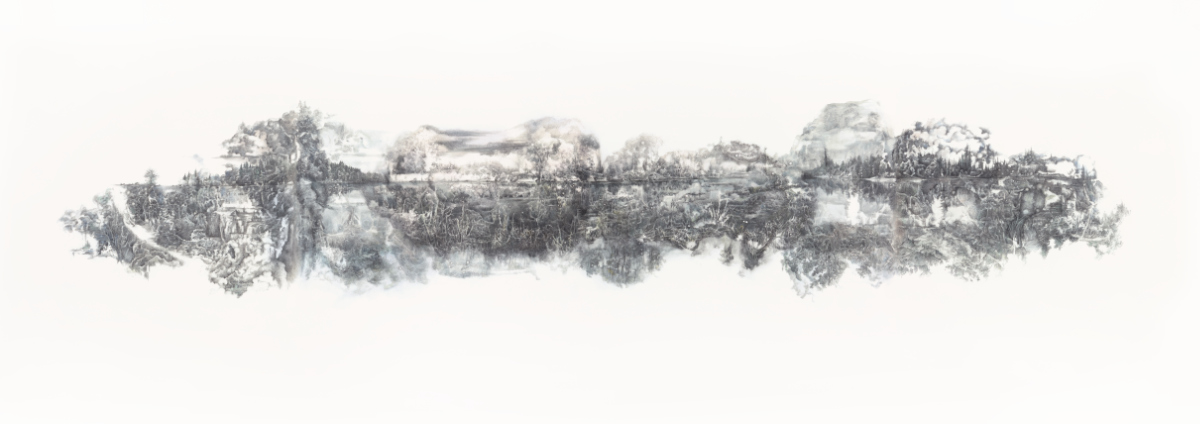
Hélène Munheim, Rémanence 11 - Horizon, 2022
Eyeshadows, ink, and graphite powder on paper, 70 x 200 cm
Photo © atelierFindArt
Courtesy of the artist
- Mel O’Callaghan
Born in 1975 in Sydney (Australia), she lives and works between Sydney and Paris
Alglass, Respire, Respire, 2019
Dielectric glass, metal wire, 125 x 100 x 77 cm
Orbe/dome, Respire, Respire, 2019
Dielectric glass, metal wire, ⌀ 150 cm x 16 cm
Etats/States, Respire, Respire, 2019
Dielectric glass, metal wire, 200 x 150 x 35 cm
Courtesy of the artist & galerie Allen
An almost transparent installation, capturing and reflecting all the variations in colors and light emanating from the lake, ‘Respire, Respire’ proposes instruments of communication with our own body, which dialogue with the surrounding landscape at the same time. The study of rituals in different civilizations, led for a long time by Mel O‘Callaghan, often takes a deep desire for communion with the human and vegetable or mineral forms that inhabit our planet as a starting point, and makes them resonate with each other and within ourselves. Through a collection of sculptures, films, paintings, and performances, the artist often explores the immersive power of trance but also, paradoxically, this way of being able to go “outside oneself,” the limits of one’s own body, to reach a state of symbiosis with what surrounds us, just like memory, gesture, and transmission. Thus, facing the lake, these crystal capsules reflect, deform, and transform the space into almost liquid matter by playing with prisms of color. The shapes of the sculptures themselves, round, elongated, convex and concave, are freely inspired by the observation of extremophiles— underwater organisms thriving in so-called “extreme” conditions—which she also captures in the film ‘Centre of the Centre’ (2019), tracing the origins of life and its regenerating forces. Therefore, it is life that we are talking about here, above all. The titles of the works thus set the tone and dictate a rhythm. ‘Respire, Respire’ thinks about the foundation of all life and exposes breath, both as an elementary impulse and as a source of connection to the abundant depths. In collaboration with Sabine Rittner (associate researcher and music therapist at the Institute of Medical Psychology at the University Hospital of Heidelberg in Germany), the artist has imagined a performance based on inhalation and exhalation techniques, aiming to provoke joy or serenity, but also and above all to
provoke altered states of consciousness and moments of meditation, ecstasy, or hallucination. In a crescendo of intensity, the work of art becomes global. The landscape opens and diaphragms too; the sound of the performer’s breaths pulsates through the works as well as the hearts of visitors.
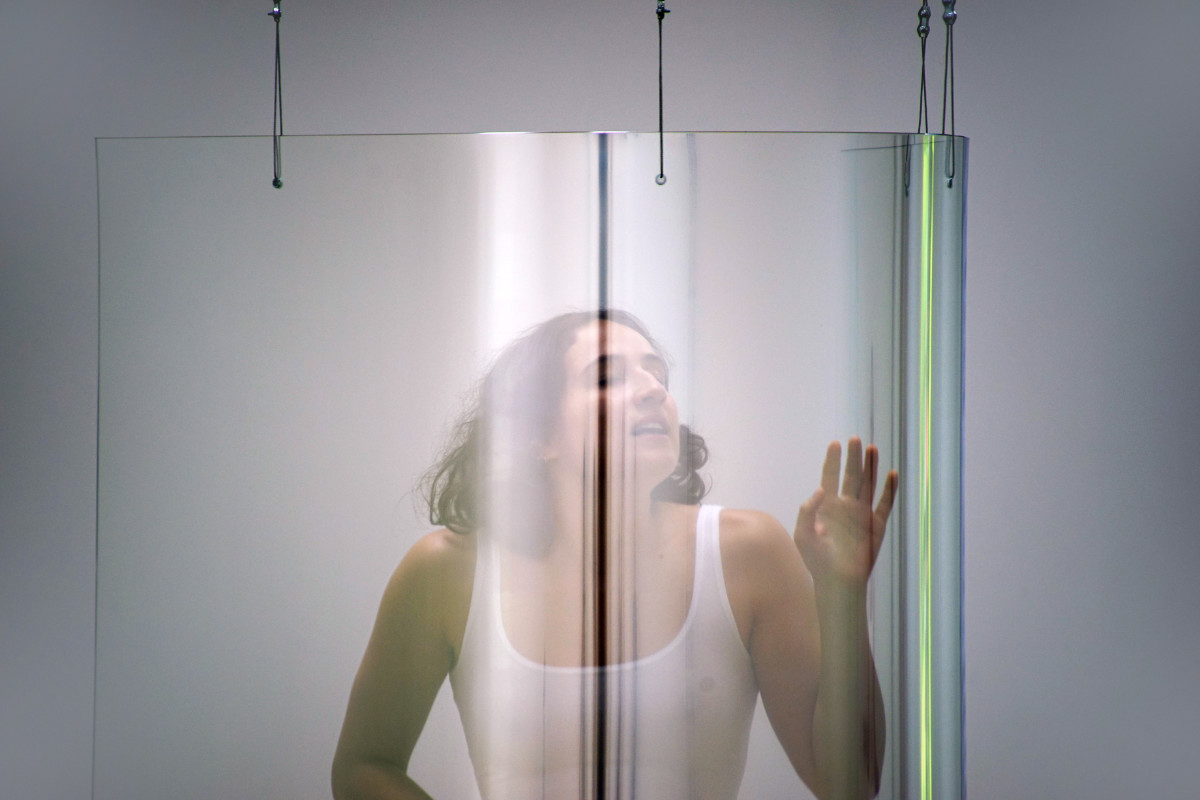
Mel O’Callaghan, Respire, Respire, 2019
Performance with breaths in dielectric glass, 20 minutes
Photo © Clemens Habicht
Courtesy of the artist & Galerie Allen, Paris
- Philippe Parreno
Born in 1964 in Oran (Algeria), he lives and works in Paris.
Snow Dancing, 1995
Acrylic, metal, 185 x 60 // 20 x 15 cm
Fondation MAMCO, Geneva
A road sign indicates the direction of an imaginary site called ‘Snow Dancing’. This sign suggests a rite of dancing in the hope of seeing snow fall, a practice considered superstitious in popular imagination. Summoned to the exhibition space, itself surrounded by mountains, its mention evokes a form of magical ritual, images of gracious collective ceremonies and enchanted landscapes. The name of the work comes from an eponymous text published in 1995 by GW Press, consisting of a transcript of a party which Philippe Parreno described to Liam Gillick and Jack Wendler. But this
description is fanciful because this evening has never taken place, or rather, not yet. Two months after its publication, hundreds of people were invited to the Dijon Consortium to participate in an
event performing Parreno’s work as if it were a script or a score. Works including the exposed panel are created in order to transform the architecture of the art centre into a place of ceremony. The latter is thus the symbol of the power of imagination and performative speech, and at the same time the traces of what has happened and the instruction for it to be reproduced. The work is part of a larger ensemble characteristic of Philippe Parreno’s approach, creating works as immersive experiences, suspended in a fictional time, between symbols and nostalgia.

Philippe Parreno, Snow Dancing, 1995
Acrylique, metal 185 × 60 cm
Photo © Annik Wetter
Courtesy of MAMCO, Geneva
- Elise Peroi
Born in 1990 in Nantes (France), she lives and works in Brussels.
Songes II, 2022
Fabric, painted silk, linen, wood, 140 x 198 x 15 cm
Nageur, 2022
Fabric, painted silk, linen, wood, 95 x 124 x 11 cm
Lalage, 2022
Fabric, painted silk, linen, wood, 95 x 138 x 11 cm
Ereme. 2022
Linen, painted silk, wood, 95 x 124 x 11 cm
Courtesy of the artist
Elise Peroi, a young French artist, says she is looking for “how to translate the breath of the landscape and the landscape itself at the same time, as an inhabited place.” The artist has a careful and meticulous approach which shows her respect for the material and for the environment, revealing a form of ecological thinking. The silk is painted and then cut. The pieces of the different worlds are then woven with each other, erasing the original paintings to rebuild a trembling, tapered painting embracing the breakages and the bonds. The alternation of emptiness and fullness allows a dialogue with the light and brings a certain degree of abstraction. The plant and mineral layers are then not seen so much as guessed, and the superposition of these layers of time with shades of ochre, green, and blue make a braid of unique compositions through which a strong relationship between landscape and memory is forged. Often the works, displayed on frames, evoke walls, offer a new perimeter of the space and suggest immersive, almost mythological environments, like the impressive fresco of the gardens of Livia, currently preserved at the Museo Massimo in Rome. This uncommon practice of weaving and painting also suggests other interests such as dance, with repeated gestures and rhythmic movements that seem to be the result of choreography. But it is undoubtedly literature that stands out as an inexhaustible source of inspiration, as well as architecture that is reflected both in the motifs of the works and in their structures. Moreover, some of her pieces have their origins in imaginary literary architectures, such as the work ‘Lalage’ which refers to one of Italo Calvino’s invisible cities, describing a place punctuated by bell towers and swings allowing the moon to rest.
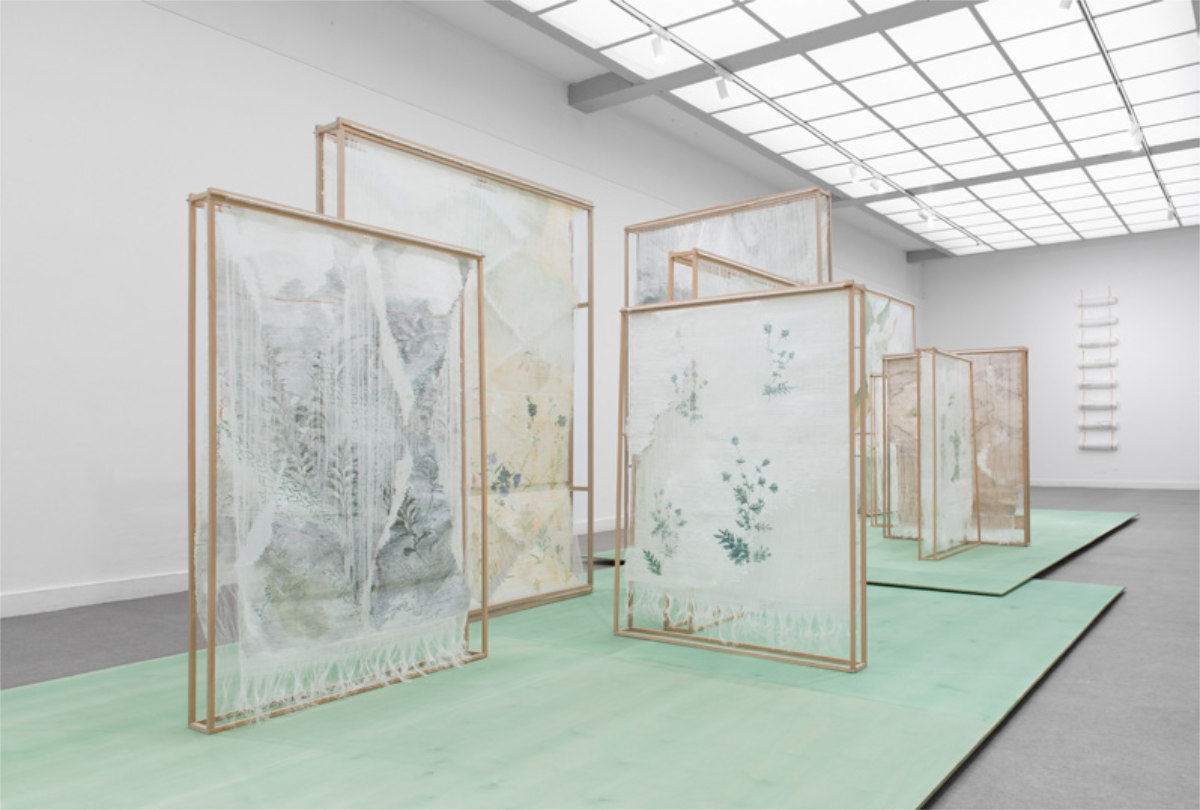
Élise Peroi, exhibition view Peut-être ce jardin n’existe-t-il qu’à l’ombre de nos paupières baissées, 2022, CACC
Photo © Margot Montigny – CACC
Courtesy of the artis
- Constant Puyo
Born in 1857 in Morlaix (France) – died in 1933 in Morlaix
Lac de Lugano, Suisse, between 1890 and 1900
Digital print from an Aristotype, 6 x 18 cm
Musée d’Orsay collection – Paris / RMN reproduction
After studying at the Ecole Polytechnique and spending several years as a French artillery officer, Constant Puyo became fully involved in the practice of photography and became one of the leaders of pictorialism alongside Robert Demachy. This movement, which unfolds between 1890 and 1914, represents a crucial stage in the history of photography: it aims to break with a photo capture practice that had become accessible, and therefore standardized, and accept it as an artistic act developing its own aesthetics and sensitivities. The principle is no longer to reproduce reality but to interpret it. In this perspective, pictorialists abound with inventive techniques to rethink the medium. They crop the images, play with the light and even find ways to intervene manually at the moment of capture. Constant Puyo will even create, with Jean Leclerc de Pulligny, a camera allowing artistic blurs. The ‚Lac de Lugano, Suisse’ photography is undoubtedly the most figurative work of the exhibition, being the only one to have a direct relationship with the place that houses it. Nevertheless, a mysterious impression emerges from it. It is as if time was suspended. Floating. Stretched over 18 centimeters, the image seems to fade gradually, as if erased by a luminous fog. On the right, the pier of a seaside resort draws the eye to the ground. The background softened by the mist suggests ghost woods and mountains. Finally, the blur gains territory until the observer is lost between lake and sky.
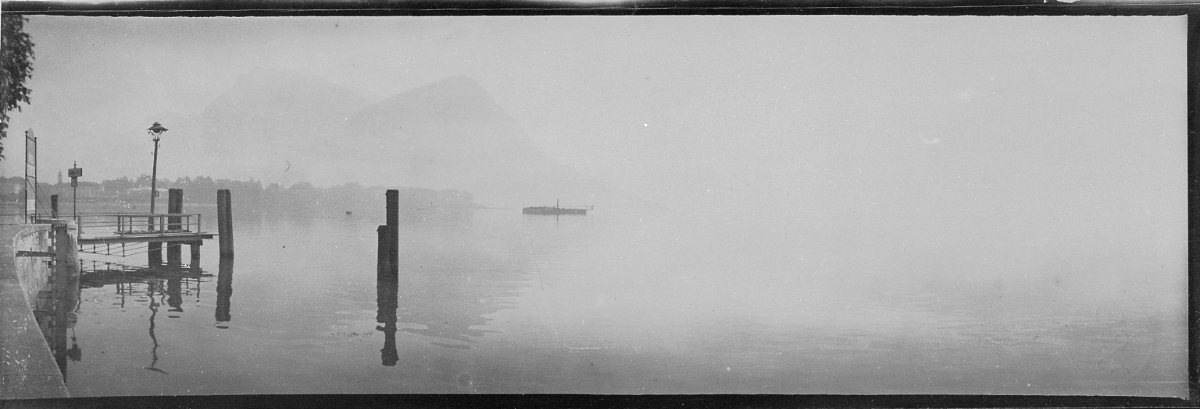
Constant Puyo, Lac de Lugano, Suisse, between 1890 and 1900
Arystotype 6 x 18 cm Paris, musée d’Orsay
Photo © RMN-Grand Palais (musée d’Orsay) / image RMN-GP
- Emilija Škarnulytė
Born in Vilnius, 1986 (Lithuania), she lives and works between Tromsø and Berlin.
Sunken Cities, 2021
Video Installation, 1h 08min (loop)
Courtesy of the artist
“Who brought you here? Some mermaid archaeologist, some modern undine, some artist-as-siren-as-museum guide. Qualcuno come onda sonora, solo come cognizione. What cities are sunk deep inside you? Does it matter?” - Quinn Latimer on Sunken Cities, 2021
With her films and installations, Emilija Škarnulytė works on the edge of documentary and fiction. Her enacted narratives witness a concern for the future of a planet exhausted by human activity. By preferring poetry to didacticism, the Lithuanian artist addresses these ecological and political issues through cosmic and geological journeys. “Sunken Cities” literally plunges the visitor into total immersion in the waters of the northwestern shore of the Gulf of Naples, while a mermaidarchaeologist explores the seabed and swims between the ruins of a vanished civilization. We thus discover the ancient city and seaside resort of Baia, the corridors, sculptures and mosaics of a sumptuous Roman empire, washed away by the waters due to underground volcanic activity. However, one might also think of Plato‘s account of the myth of Atlantis, with its descriptions of the rise and sudden fall of this mysterious lost city, the source of a superior humanity: the film calls upon the figure of the mermaid of Nordic legends, and this is no minor detail. A solitary undine, she moves silently in search (in vain) of other forms of life when everything seems to have disappeared, exploring this disappearance. A game of echoes is then set up between this symbolism and the film itself, with captivating camera movements that highlight a deserted landscape, a meditative soundtrack inviting
contemplation, and plunging the viewers into a state of total solitude. The apparent appeasement of the whole gives way to a kind of anxious feeling about this city that has become a relic. And it raises waves of questions: does the work announce the end of other empires in times of climate crisis? What will survive of humanity? What is hidden in the deep waters?
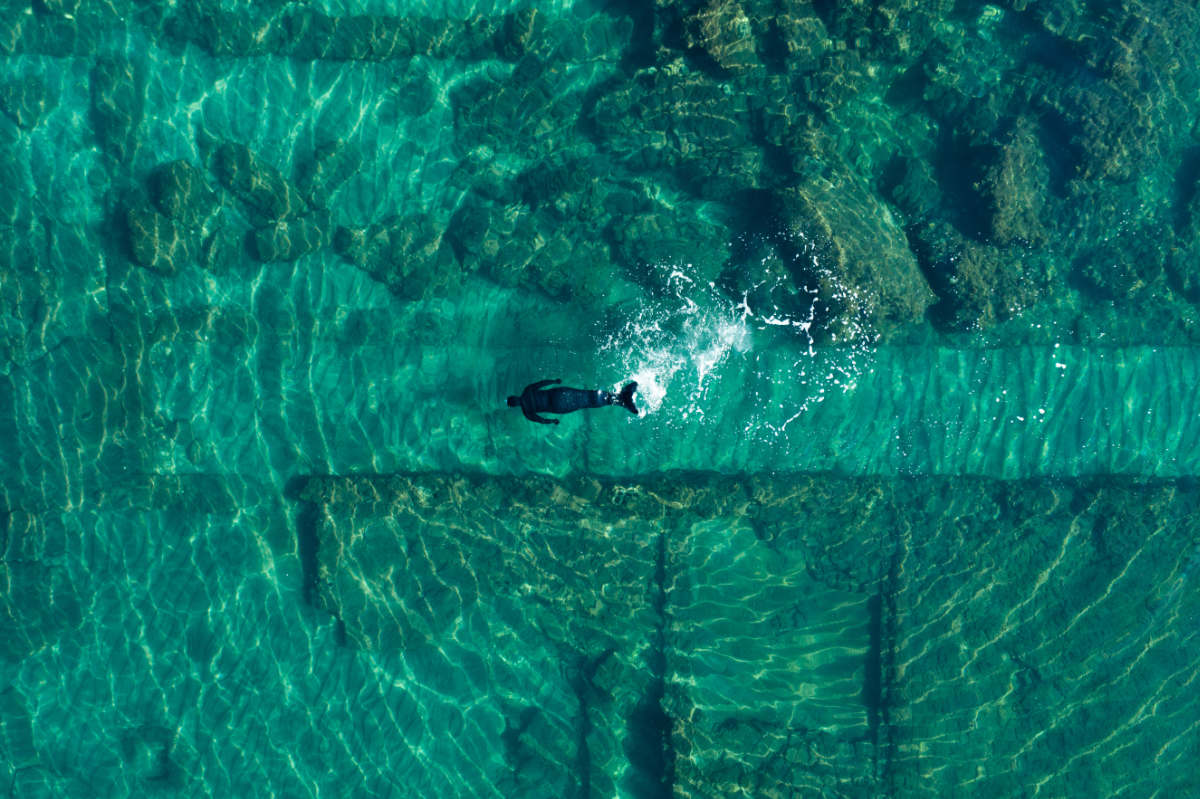
Emilija Škarnulytė, Sunken cities, 2021
Excerpt from the video
Courtesy of the artist
- Haim Steinbach
Born in 1944 in Rehovot (Israel), he lives and works in New York
Close your eyes, 2003
Matte black vinyl lettering, variable dimensions
MAMCO Collection, Geneva
Work acquired thanks to the Association des Amis du MAMCO, Philippe Bertherat, an anonymous donor and the Mirabaud bank
Since the mid-1970s, Haim Steinbach has been interested in the difference between seeing and looking, between discerning and understanding. He is known for his assemblages of everyday objects collected and exhibited on shelves, legacy works by Marcel Duchamp, that question how context influences our perception of an object or situation, and gives it new meanings and identities. Following a similar logic, Haim Steinbach also collected pieces of text, statement objects that he later transferred to a sheet or a wall in their original typographies. By taking them out of their contexts and projecting them into the museum environment, the sentences he selects reprogram our use and understanding of language. A phrase like „Close your eyes,” used on many occasions (to prepare for a surprise, to protect ourselves from a sight that we prefer to avoid, or to relax or fall asleep) here takes on importance through unusual lettering. The injunction, whether read as an imperative order or as the statement of a rule of a game, may also seem absurd in an exhibition space where the entire aim should be to observe works. By just closing their eyes, the visitor is fittingly invited to “see” differently. By appealing to other senses than sight, visitors enter a world full of possibilities. In ‘The Unknown Lake’, and facing the lake by the bay window, the work acts as an instrument of transition and invites us to an intimate search: to leave the external landscape in order to look and see the landscape sunken in each of us.
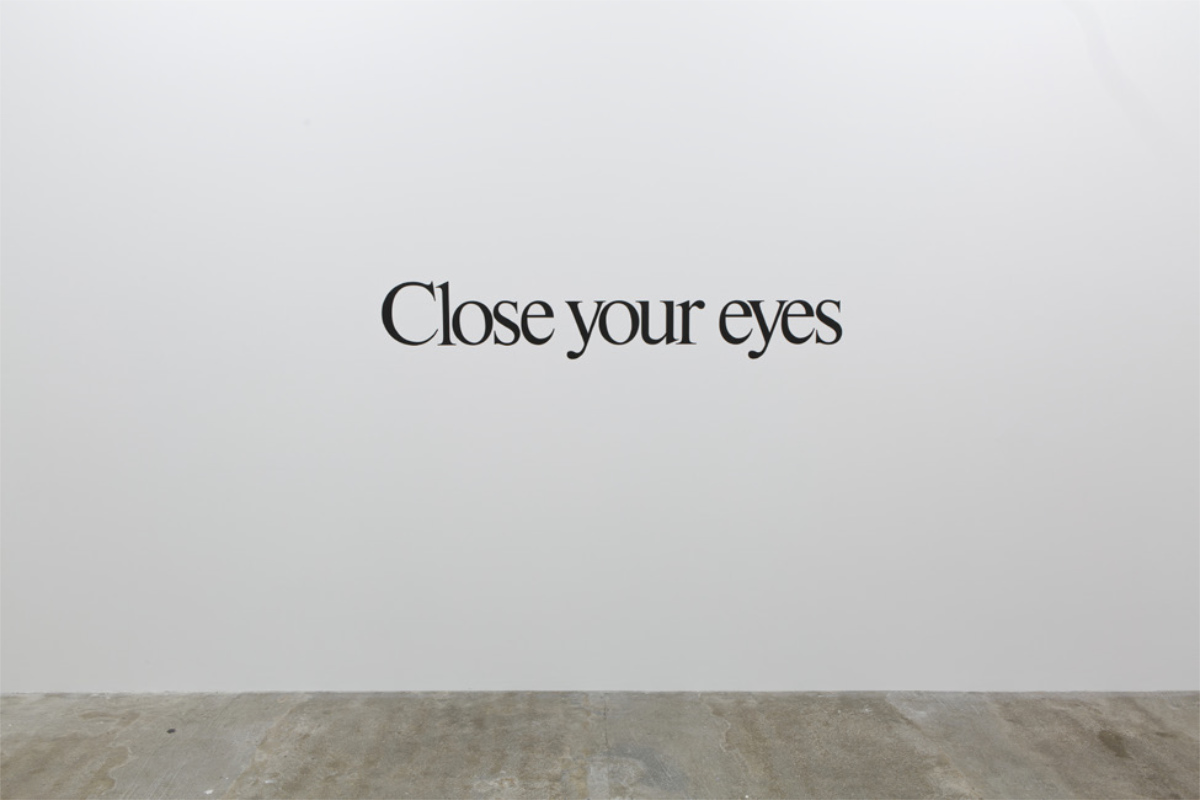
Haim Steinbach, Close your eyes, 2003
Exhibition view, Haim Steinbach, Who’s there?, Galerie
Laurent Godin, 2022
Photo © Galerie Laurent Godin
Courtesy of MAMCO, Genève
- Willa Wasserman
Born in 1990 in Evansville (USA), she lives and works in New York
Moon, 2022
Oil on copper 37.5 ⌀ cm – private collection
Convex still life (basket & urn), 2020
Oil on poplar, ⌀ 27.9 cm
Convex still life (sisyrinchium bellum, violets), 2019
Oil on poplar, ⌀ 38.1 cm
Sydney, 2019
Oil on blackened steel, ⌀ 20.3 cm
Courtesy of the artist & galerie High Art, Paris
Willa Wasserman paints the memories that escape us, the fantasies that inhabit us, the ghosts that haunt us. Her works travel between self-portraits, intimate portraits, and subjects inherited from motif painting, where the artist seems to welcome a classical iconography, an assumed legacy of traditional artistic practices in the history of Western and dominant art, in order to better defuse it. Willa Wasserman paints nudes and bouquets of flowers, often drawn in round shapes. The “tondos” that refer to the 15th century Madonnas as much as a more domestic form of painting that was embedded in the antique moldings. The works are not always done on canvas but often on metal, a medium which allows the paint to swallow and gently reflect the light. The artist also makes use of the metal tip, a drawing technique dating back to antiquity and widely used during the Renaissance, which finely carves into the material. This process helps to disturb the image, to abstract the figurative. To make what has been lost or erased invisible, as if to better honor that which is absent. Playing with the potential oxidation of the metal, its patina and its verdigris rust in the case of brass or copper, Willa Wasserman also works on the skin of the piece. Whether morning pink or full moon blue, time will give it other tones as if by magic. Her study of light, reflections, and movement unfolds in compositions where haziness and fluidity are key, and her distortions recall the intangible effects of fog in the forest or aquatic reflections in the moonlight. The works echo within the rooms of the villa, the landscape that surrounds it, giving the whole piece a special aura, a dive into this ethereal painting, like a secret that can be contemplated without ever really being deciphered.
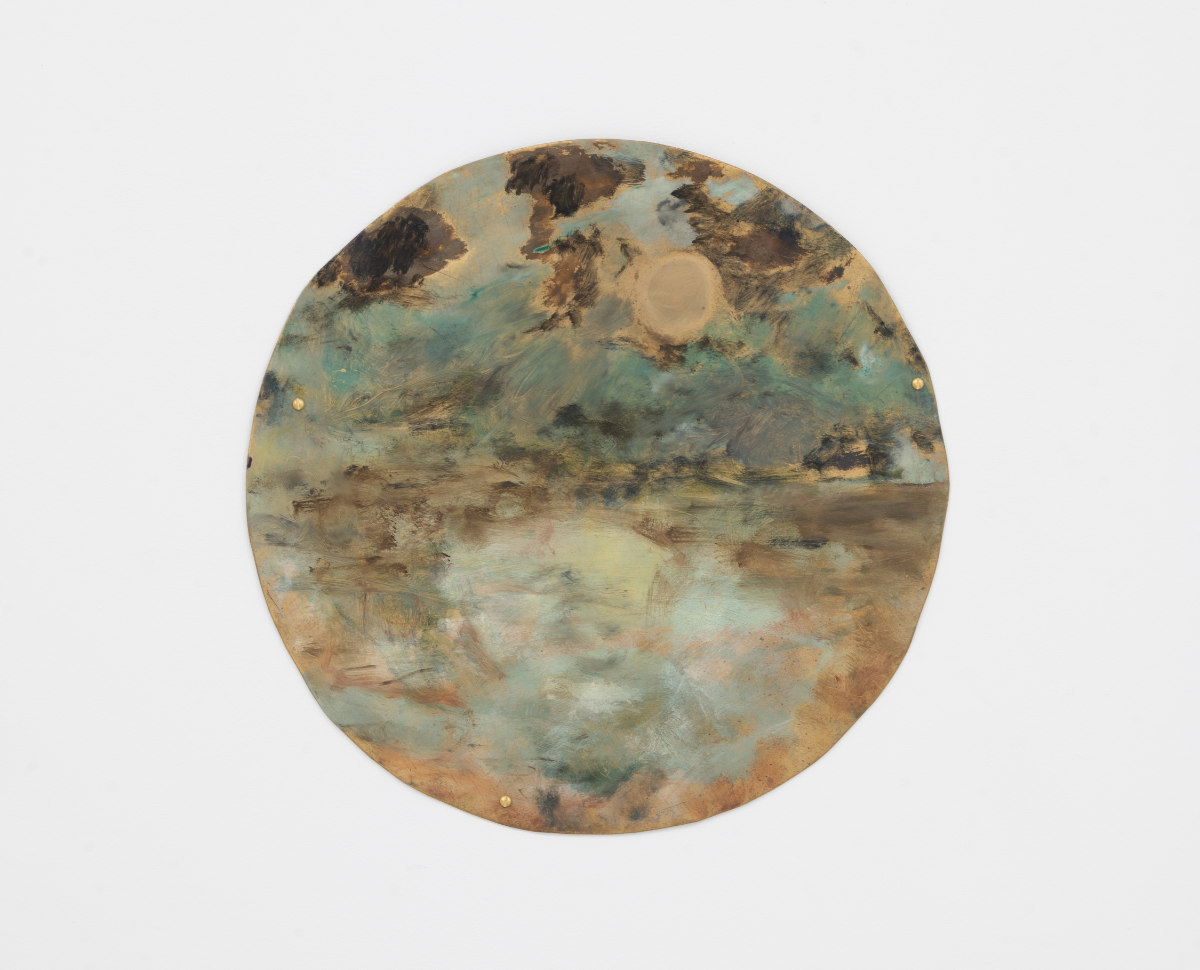
Willa Wasserman, Moon, 2022
Oil on copper, 37.5 ⌀ cm
Courtesy of the artist & High Art, Paris








